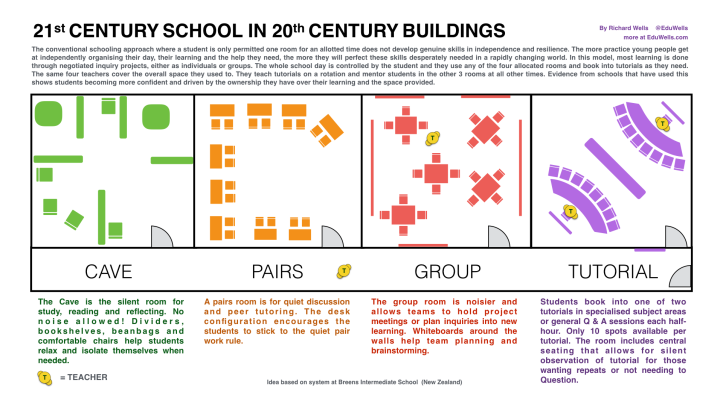If you ask me, the elephant in the classroom, especially high school classrooms has always been the fact that teachers would rarely choose for themselves, the daily experience they inflict on their students. [Img Cred]
If you ask a high school teacher if they’d be happy with a daily experience such as:
- an hour of trigonometry;
- an hour of Macbeth;
- an hour of plate tectonics;
- an hour of tennis, followed by
- an hour of chemical reactions
- with no attempt to relate any of the learning.
- oh, and do you want to sit in the middle of 300 teenagers for an hour long assembly?
Nearly all teachers say NO! (I’ve asked many)
So, two questions for schools:
1. What excuses do we have for creating a learning experience we wouldn’t choose for ourselves?
2. Why are we surprised at an increasing dropout rate and general switching off from school in a connected and active world of Facebook and Youtube?
An alternative with positive outcomes.
This year a visited a school that had re-purposed their existing physical classroom / corridor spaces, and redesigned their timetable to create a whole new learning experience. I could see within 10 minutes that the students were more driven and positive about school than in most schools I’ve been to. It did this by dividing itself into a mini-schools within the site. Rather than confine each student to a particular room from which learning would be ‘received’, every student had permission to design their own school day (every day) and had free access to up to 4 differently purposed rooms depending on what their needs were at any particular moment.
New use of school space
The 4 rooms that each child had free access to would include:
- a “Cave” (silent room),
- a pairs room (for peer tutoring),
- a group room (for project/teamwork)
- a tutorial room (They had to book into tutorials that the teachers ran on a rotation).
It was up to the children to use these spaces according to needs and be responsible for productive time management. Something that was very evident during my visit, where I could see that through practice and extensive experience in self-driven learning, the average student was more confident, organised and keen to discuss their progress.
New use of School time
Students are free to organised their own day. They had to book into a certain amount of tutoring in a week but by choice could tailor the tuition to their needs. They negotiated inquiry projects at the beginning of terms and worked on them in teams. They were encouraged to work together and solve their own problems. They also booked out technology from a central hub when required, rather than assume that technology was a must all day, like some schools suggest.
New use of Teachers
Teachers rotate between giving tutorials and roaming as mentors. A nice touch is for the principal to be signing off the final projects. Teachers have more time to talk to students and guide teams in their negotiated inquiries. Teachers were happier through working with students who were intrinsically motivated to learn on projects designed by themselves. All the national curriculum and regular content was still covered and any direct teaching needed was available, just never in a one-size-fits-all approach.
Question the old, not the new
One simple piece of advice is to spend more energy challenging your school’s status quo, than any alternative that might be suggested. Turn around and challenge that “elephant” that so many teachers and even more students are talking about.


